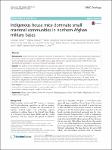Indigenous house mice dominate small mammal communities in northern Afghan military bases
Gertler, Christoph
Schlegel, Mathias
Linnenbrink, Miriam
Hutterer, Rainer
König, Patricia
Ehlers, Bernhard
Fischer, Kerstin
Ryll, René
Lewitzki, Jens
Sauer, Sabine
Baumann, Kathrin
Breithaupt, Angele
Faulde, Michael
Teifke, Jens P.
Tautz, Diethard
Ulrich, Rainer G.
Background: Small mammals are important reservoirs for pathogens in military conflicts and peacekeeping operations all over the world. This study investigates the rodent communities in three military bases in Northern Afghanistan. Small mammals were collected in this conflict zone as part of Army pest control measures from 2009 to 2012 and identified phenotypically as well as by molecular biological methods. Results: The analysis of the collected small mammals showed that their communities are heavily dominated by the house mouse Mus musculus and to a lesser extent Cricetulus migratorius and Meriones libycus. The origin of M. musculus specimens was analyzed by DNA sequencing of the mitochondrial cytochrome b gene and D-loop sequences. All animals tested belonged to the Mus musculus musculus subspecies indigenous to Afghanistan. The results were supported by detection of two nucleotide exchanges in the DNA polymerase gene of Mus musculus Rhadinovirus 1 (MmusRHV1), a herpesvirus, which is specific for all gene sequences from Afghan house mice, but absent in the MmusRHV1 sequences of German and British house mice. Studies of astrovirus RNA polymerase gene sequences did not yield sufficient resolution power for a similarly conclusive result. Conclusions: House mouse populations in military camps in Northern Afghanistan are indigenous and have not been imported from Europe. Nucleotide sequence polymorphisms in MmusRHV1 DNA polymerase gene might be used as an additional phylogeographic marker for house mice.
Dateien zu dieser Publikation
Keine Lizenzangabe

